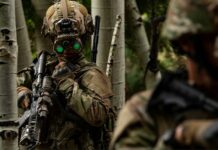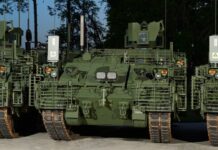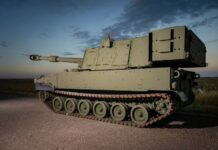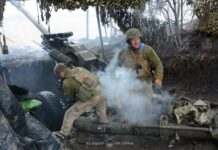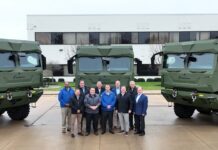The US Army is currently developing the Next Generation Combat Vehicle (NGCV) family of systems. The goal is to prepare infantry formations for the changing face of manoeuvre warfare.
This goal is to be accomplished by replacing decades-old combat vehicles with more capable modern systems and simultaneously introducing brand new technologies and capabilities. In addition to improved manoeuvre and combat capability, the innovations are intended to enhance soldier survivability.
OMFV & RCV Broken Down
The overall programme is managed by the Army Futures Command Next Generation Combat Vehicles Cross-Functional Team, or NGCV CFT, based in Warren, Michigan. There are four component programmes within the NGCV purview:
- the Armored Multi-Purpose Vehicle (AMPF) to replace the M113 armoured personnel carrier
- the Mobile Protected Fires (MPF) light tank to support light infantry brigades
- the Optionally Manned Fighting Vehicle (OMFV) to replace the M2 BRADLEY Infantry Fighting Vehicle (IFV)
- the completely new category of the Robotic Combat Vehicle
This article will discuss the status of the latter two component programmes.
The OMFV Programme
The OMFV programme was initiated in Fiscal Year 2018 (FY 2018). The programme aims to develop a successor to the M2 BRADLEY IFV which entered service in 1981. While the BRADLEY has undergone repeated upgrades, the framework has now reached the limits of growth. In order to incorporate future technologies and achieve new capabilities required to retain battlefield superiority, a clean-sheet new design is deemed necessary.
The mission profile mirrors that of the BRADLEY, and includes battlefield infantry transport, fire support, and direct engagement of enemy vehicles. According to the Army, the OMFV is intended to not merely replace the BRADLEY, but to “bring transformative flexibility and lethality capabilities to future battlefield commanders.” The “Optionally Manned” portion of the vehicle designation refers to the required ability to be remotely operated by a dismounted crew. The OMFV is also being designed to operate in tandem with the fully unmanned Robotic Combat Vehicles currently under development.
Specifications
The Army has identified four specific capabilities required of the new vehicle:
1) Enable command and control at the platoon level and higher by rapidly generating, receiving and passing information to dismounted elements, other vehicles and command nodes.
2) Provide decisive lethality by detecting, engaging and destroying enemy IFVs beyond range of the enemy’s primary weapon system, while also defeating dismounted infantry. OMFV is further intended to enhance unit-level lethality by contributing targeting data and situational awareness.
3) Reduce logistical burden through enhanced reliability and on-board diagnostics and prognostics, ease of maintenance, and a simplified supply chain for parts and consumables.
4) Built-in growth margins for easy insertion and integration of future technologies including enhanced armour, vectronics, and the potential for electromagnetic-spectrum weapons. To this end, OMFV is conceived from the beginning as a Modular Open Systems Architecture (MOSA) platform with standardised hardware, software and data interfaces. The MOSA itself is based on Army designed- and owned standards. This will enable the Army to regularly modernise existing vehicles quickly and at reduced expense.
The Five Phases of OMFV
OMFV is being developed through open-source contracts, and is the first major ground combat vehicle being developed using digital engineering. The programme is divided into five phases:
- Market Research and Requirement Development (completed early 2020)
- Concept Design: The programme is currently in Phase 2. The Army awarded five competing firms contracts for digital concept design in July 2021: American Rheinmetall Vehicles, LLC; BAE Systems Land Armaments L.P.; General Dynamics Land Systems, Inc.; Oshkosh Defense LLC (in partnership with Hanwha Defense); and Point Blank enterprises, Inc. The ongoing Concept Design phase focuses on digital modelling, simulation and analysis (MSA) to inform requirements and support initial design efforts. This approach enables the Army to evaluate designs as they evolve, and test their operational viability and performance potential through modelling and simulations
- Detailed Design: Phase 2 will be followed by a full and open competition for Phase 3, which will lead to mature OMFV designs. Other firms beside the five participants of Phase 2 will be eligible to present their independently developed digital designs for Phase 3 consideration. The Army intends to award up to three detailed design phase contracts in the second quarter of FY 2023. Phase 3 will culminate in late FY 2024 with a Comprehensive Design Review (CDR). The CDR will determine whether prototype designs meet baseline requirements and demonstrate technical maturity and manufacturing viability.
- Prototype Build and Test: Successful conclusion of the CDR will pave the way for Phase 4 to be conducted 2025 through 2027. According to a 1 July 2022 Army announcement, each contractor participating in Phase 4 will build and provide between seven and 11 physical prototypes of their production-model design, plus two ballistic hulls and turrets, armour coupons, and digital engineering data. Prototype vehicles will be tested and evaluated against the Army’s OMFV performance specifications. Toward the end of the prototype build and test phase the Army will conduct a Limited User Test (LUT) to address issues which were identified during the acquisition process to date.
- Production and Fielding: Presuming a satisfactory outcome of the prototype testing, the Army can subsequently decide to proceed to programme phase 5, production and fielding. A single competitor will receive an LRIP contract in late FY 2027. The initial tranche of OMFVs will undergo rigorous operational testing. The Army expects to equip the first mechanized infantry unit with the OMFV during FY 2029. A full-rate production (FRP) decision is expected in Q2 of FY 2030.
RfP for OMFV Phases 3 and 4
The Army’s budget request for 2023 calls for circa US$590m in OMFV Research, Development, Test & Evaluation funding. Part of the funding is intended for source selection for Phase 3 and Phase 4 contractors in the Second Quarter of FY 2023. Funding may double to US$1.2Bn in 2024.
The contract awards the Army plans to grant in the second quarter (Q2) of FY 2023 will simultaneously cover both Phase 3 and Phase 4 of the OMFV programme, with the same vendors automatically being chosen for both segments of the programme. Both phases together will run for 54 months (18 months for Detailed Design, followed by 36 months for Prototype Build and Test).
The final revised Request for Proposals (RfP) for these two phases of the programme was issued on 1 July 2022, with industry responses due by 1 November 2022. During the design and simulation process of Phase 2, the Army was reluctant to impose excessively detailed requirements, but let industry pursue optimal methods to endow the OMFV with nine vital “characteristics.” Despite the insights and lessons learned during that process, the requirements included in the latest RfP – while exhibiting a “slightly greater level of detail” – are not “final requirements,” said Brig. Gen. Glenn Dean, programme executive officer for ground combat systems.
The Army wants to leave room for industry interpretation in order to maximise flexibility and innovation during the continued design process of Phase 3, he said on the sidelines of the June 2022 Eurosatory exposition in Paris.
The RfP was published on the US government’s contracting website on 1 July 2022. While the document has 100 attachments, a large number of attachments remain classified and were not made available to the public. This includes attachments 0008 (vehicle architecture) and 0029 (classified specifications). However, Gen. Dean was able to reveal a few of the Army’s highest-level priorities. These include:
- A medium weight (40–50 ton) tracked chassis
- two-person vehicle crew plus six dismounts (to ease the transition from the current BRADLEY three-person crew configuration (the OMFV will include a third crew station which can be utiliSed until sufficient vehicle automation is integrated and proven)
- A medium calibre main gun (minimum 30mm, with a preferred objective of 50mm), possibly augmented by Anti-Tank Guided Missiles (ATGM) or other weapons
- The ability to perform silent manoeuvre and silent watch operations, which will de facto require a hybrid electric propulsion system.
In addition to the operational capabilities profile, the flexibility provided by hybrid propulsion will contribute to reducing the vehicle’s logistics footprint and reducing the impact of fuel-supply disruptions, which the Army has identified as a major area of concern.
The RCV Programme
Robotic Combat Vehicles are intended as armed escorts for manned combat vehicles and are to be incorporated into infantry and armoured brigade combat teams (manned– unmanned teaming or MUM-T). Missions include:
- armed over watch
- scouting for enemy forces
- ambush detection
- obstacle breaching
- flank protection
RCVs will be remotely controlled via radio link from within the formation’s manned vehicles. The Army is also considering semi-autonomous unmanned vehicles if AI maturity permits their safe operation.
The vehicles will feature modular, open architecture designs and will be able to incorporate interchangeable mission equipment modules to meet various operational requirements. Attributes expected across all classes include:
- Assured Position, Navigation and Timing (A-PNT) capable of defeating enemy jamming
- tethered unmanned aerial systems (TeUAS) for surveillance and targeting
- Counter UAS (CUAS) systems
- smoke generation (visual and multispectral)
- CBRNE (chemical, biological, radiological, nuclear, and explosive) stand-off detection
- Electronic Qarfare (EW) capabilities.
All Shapes and Sizes
The Army plans to procure RCVs in three different size categories.
- Light vehicles (RCV-L) are to weigh no more than 10 tons and be air transportable by rotary lift aircraft. Dimensions (LxWxH) are not to exceed 569x224x239 cm. The RCV-L is intended to be “expendable” but should be robust enough to survive a first encounter with dismounted forces and relay the situational picture to operators. The RCV is intended to operate up to two km ahead of the controlling vehicle, both to ensure a secure radio link and to keep the robot within supporting range of the controlling vehicle’s direct fire weapon. The RCV-L will carry its own stabilized primary weapon with a 360° arc of fire, capable of defeating infantry and unarmoured vehicles; the ability to stow and fire one ATGM in order to degrade a heavy armoured vehicle or breach an obstacle; the ability for future integration of a weapon station capable of defeating infantry and of mounting two ATGMs. Despite the armament, the RCV-L is expected to be deployed primarily in the reconnaissance role, using sensors to provide situational awareness and targeting data for other forces.
- Medium vehicles (RCV-M) will fall between 10 and 20 tons and require a C-130 for airlift. Dimensions should not exceed 584x272x239 cm. These robots will be designed for greater durability and lethality, with the ability to defeat light to medium-armoured vehicles. A medium calibre main weapon system will be required to balance lethality and mobility. The RCV-M is expected to qualify for direct fire support missions.
- The heavy RCV-H will weigh in at 20 to 30 tons and maximum dimensions of 889x366x361 cm. Two vehicles can be transported per C-17. The RCV-H will mount direct fire weapons and be capable of defeating all known enemy armoured vehicle. The weapon system is categorized as “durable,” which requires it to have comparable survivability to manned armoured vehicles. As presented by Maj. Cory Wallace, RCV requirements lead officer, in 2021, “the RCV heavy is a robotic tank. So just as an M1A1 — or M1A2 — can deliver decisive lethality via onboard means, so too can the RCV heavy.”
RCV Progress to Date
The RCV-H concept began testing in 2019 using remote-controlled M113 APCs as surrogates, teaming with manned BRADLEY IFVs. The evaluation culminated in July–August 2020 during a month-long exercise at Fort Carson, Colorado. Communications interface and vehicle remote control were found satisfactory. The testing also verified the basic tactical advantage of deploying RCVs as scouts and force protection assets in advance of manned units. Nonetheless, since then the Army has focussed its efforts on the Light and Medium variants. According to RCV product manager Lt. Col. Christopher Orlowski, RCV-H is now lagging behind the other two weight classes by a significant margin. At this time the future of the heavy robotic combat vehicle is unclear.
Since 2020 the Army has been integrating the Project ORIGIN vehicle into platoon level tactical exercise and training scenarios alongside manned vehicles or dismounted infantry; this includes a month-long Soldier Operational Experiment (SOE) conducted in November 2020 at Fort Benning, Georgia. This 8×8 wheeled unmanned ground vehicle (UGV) can be fitted with a broad array of lethal and non-lethal modular mission packages (MMP). The experimentation has provided significant amount of insight into deployment concepts, the challenges inherent in battlefield manned–unmanned teaming, and the overall operational utility of RCVs.
However, the Project ORIGIN UGV is too generic to investigate the full potential of a future RCV-L or RCV-M. In January 2020 the Army awarded QinetiQ North America a contract for four RCV-L surrogates, and Textron a contract for four RCV-M surrogates. QinetiQ, in partnership with Pratt & Miller, chose to submit a derivative of the Expeditionary Modular Autonomous Vehicle (EMAV), while Textron, in cooperation with Howell & Howell and FLIR, submitted the M5-E variant of its Ripsaw unmanned ground vehicle.
The vehicles, which were delivered from late 2020 through mid-2021, meet the size and overall performance parameters of the respective RCV classes, and can mount the various MMPs under consideration. However, while purpose built for the evaluation phase of the RCV programme, they are not the actual competitors for production contracts. The results of surrogate testing will guide the Army in formulating precise technical and performance requirements of future production RCVs. The surrogates will also be more optimal platforms for developing tactics, techniques and procedures to realistically enhance combat units’ lethality through MUM-T.
Next Steps
Following a year of software integration, training of operators, and general evaluation (including live-fire testing), the surrogates are scheduled to be put through their paces in an extended SOE to be conducted between June and September 2022 at Fort Hood, Texas. The SOE at Fort Hood will see the first company-level deployment of RCVs, with all four Light vehicles operating as a unit, and four RCV-Ms operating as a second complete unit. The RCVs will deploy in both attack and defend roles.
Following a year of software integration, training of operators, and general evaluation (including live-fire testing), the surrogates entered an extended SOE in late July 2022. The evaluation is being conducted at Fort Hood, Texas and will continue until late summer The SOE at Fort Hood involves the first company-level deployment of RCVs, with all four Light vehicles operating as a unit, and four RCV-Ms operating as a second complete unit. The vehicles are being deployed in both attack and defend roles. Onboard systems being deployed include the tethered UAS, a counter-UAS jammer, a modular smoke obscuration module, a Common Remote Operated Weapon System (with crew-served weapons up to 50-caliber, and a JAVELIN ATGM), and an autonomous drive function. Performance over a broad spectrum of realistic battlefield terrain, as well as the vehicles’ ability to identify and avoid obstacles and to fire weapons while on the move, are major aspects being evaluated. Additional SOEs are planned over the next 36 months. “Soldier feedback is the foundation for every single requirement we’re writing” in order to ensure that engineers design systems that are truly useful in the field, said Maj. Wallace.
Testing and Selection
RCV-L now has the highest priority within the robotic combat vehicle programme. In February 2022 it was categorised as a rapid prototyping project, with the intent to speed development of an operational system. According to a briefing conducted by Lt. Col. Orlowski in April 2022, the RFP for RCV-L will be published in the September–October 2022 timeframe, leading to an open competition for the engineering and manufacturing development (EMD) phase. Up to five firms will be selected for EMD contracts in Q4 of FY 2023. Each firm will submit two full-system prototypes to the Army for testing, which will continue through Q3 of FY 2024. This will lead to downselect of a single contractor, who will be required to submit additional prototypes for further in-depth testing through 2026. Prototype evaluation and testing is expected to wrap up in Q3 of FY 2026, with a decision to progress to serial production to be made between Q4 of FY 2026 and Q2 of FY 2027. Army budget documents for FY 2023 show that approximately US$700M are being requested for RCV-L over the next five years. This figure includes funding for continued surrogate testing as well as software development.
A decision regarding progression to the EMD phase of the RCV-M programme is planned for FY 2024. Lt. Col. Orlowski stressed in April that the RCV-M prototyping and fielding timeline is still conceptual and subject to Army senior leadership approval.
Meanwhile, evaluation of the current RCV-L and RCV-M surrogates is scheduled to continue through the end of FY 2025. Participating soldiers’ feedback will inform the design of the operational prototypes, and identify components and capabilities that should be included. Major aspects of the surrogate evaluation will focus on vehicle autonomy software, cybersecurity, and spectrum resiliency.
Manned–Unmanned Teaming – Wave of the Future
It is no accident that OMFV and RCV are being developed simultaneously. Manned–Unmanned Teaming is slated to assume an important role in future Army combat operations, both to reduce exposure of soldiers and to extend the operational range and situational awareness of ground formations. “If you could extend the battlefield up to two kilometres with a robot, then that means that you can make decisions before your enemy comes,” said Maj. Gen. Ross Coffman, director of the Next Generation Combat Vehicle Cross Functional Team at the US Army Futures Command (AFC), in June 2021. Coffman, who was selected in June 2022 for promotion and appointment as deputy AFC commander, added that RCVs could be used to lure an advancing opponent in while manned units withdraw. “Now you can pair these robots with unmanned aerial vehicles and they’ll continue to report, continue to engage and make the enemy deploy faster. We can then [unleash] mass-effects on their main effort,” he stated.
Depending on the requisite firepower up front, remotely controlled OMFVs could add their firepower to the robotic front line. The ongoing and imminent test and evaluation cycles for both OMFV and RCVs will determine whether unmanned systems are best suited to relieving manned vehicles from the most dangerous battlefield roles, or whether they can enhance total force lethality by assuming new roles. While robotic combat vehicles will never replace the human soldier as the core element of ground warfare, MUM-T will make its mark on tactics and doctrine over the coming decade and more.





